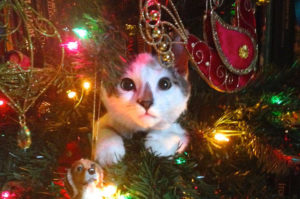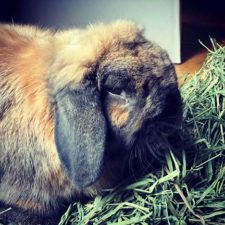Christmas. It’s the most wonderful time of the year. Unless, of course, you end up rushing your beloved pet to the vet due to an avoidable emergency.
For humans, the holidays bring twinkling lights, gaily wrapped packages, rich foods, and adult beverages served by the fire in the company of friends and family who come to call. And while we don’t want to sound like the Grinch, each one of these things presents a possible hazard.
Here’s how to avoid them so your pet can enjoy a safe, happy holiday.
Trees and Decorations
Christmas trees are irresistible, especially to a cat. “Why bring a tree in the house if you don’t mean for me to climb it?” your kitten may ask, and if you have a cat or kitten, you may spend a good deal of the time shooing her away from the tree or fishing her out of it. Climbing within itself isn’t usually a danger, but make sure the tree is secure since a falling tree can hurt your cat, especially if it gets tangled in the lights.
Another potential danger is tinsel. Those shiny strands of strings just beg to be swatted, chewed and consumed, but tinsel impactions result in emergency surgeries every year, so if you have pets, avoid the tinsel.
You may also want to avoid breakable ornaments that can get knocked off and shatter, cutting your pet’s paws.
Also, watch those cords. This may be the most dangerous decorating hazard of all, especially if you have a dog that likes to chew. Consider running cords through a piece of PVC pipe to keep Fido from getting a nasty – and possibly fatal – shock to the mouth.
The final decoration to consider is plants. Although we’ve been told for years that Poinsettias are deadly, they are not. Mistletoe and holly, however, are highly toxic and should be kept away from pets. If you must use them in decorating, consider some of the very realistic artificial versions of these holiday favorites.
Packages
The danger often starts when these are delivered. UPS and FedEx drivers are everywhere, and the seasonal drivers are under a lot of pressure to deliver their packages on a time schedule. It’s easy to overlook an old dog ambling across the driveway as they’re leaving. You should always observe leash laws, but at this time of year, it can be vital.
Once the packages are inside and ready for wrapping, remember that think ribbon presents the same danger as tinsel. Make sure any ribbon on packages you put under the tree is secure.
Food and Drink
This may be the biggest hazard of all. Everyone loves to eat, but when we’re gathered around the table, we should be mindful not to let that generous mood extend too freely to our pets. The fat content in turkey is a common cause of pancreatitis in dogs who overdo this holiday favorite. Throw in a bit of stuffing that contains onions toxic to Fido, and you could be facing a big Christmas vet bill.
Even sweets can present a hazard. Chocolate is toxic to cats and dogs, although dogs are more likely to indulge their sweet tooth and are more at risk. But did you know some artificial sweeteners can be deadly to your pets? If you cook with Xylitol, make sure to keep those baked goods and even Xylitol residue away from your pets, as it is extremely toxic.
Alcohol, too, is a hazard. This time of year, we imbibe in sweet, creamy drinks like spiked eggnogs which may appeal to pets in a way straight liquor may not. So be mindful not to leave libations in reach of your pets.
Another food-related risk is intestinal torsion. This is usually a hazard for large breed dogs who eat a big holiday meal themselves and then go romp with the kids. One roll on the ground with that full belly can cause the gut to twist on itself. This is a life-threatening medical emergency characterized by discomfort, bloating, and a failed attempt to vomit. If you have a large breed dog, do not overdo it on the holidays. If you must indulge your pet, do it with multiple small ones, not one large one.
Guests
You love your sister and her family, but if you saw them from your pet’s perspective, you may not feel the same way. An animal used to the quiet life and a steady routine can be extremely stressed by the sudden arrival of loud human visitors, especially if those visitors include children who haven’t been taught not to pull on or pick up animals.
The fear and stress an animal feels by the overwhelming presence of noisy strangers can cause behavioral and health issues. Cats, feeling too terrified to travel to their litter box, may hold their urine or start urinating outside the box while dogs may snap if fearful.
Keep in mind that your guests aren’t always on the lookout for a door-darting cat or dog, and with so much activity, your pet could slip out and go missing very easily. If you live in a rural area where your dog isn’t fenced, remember that guests coming and going present an additional risk to your pet, so consider confinement if you’re expecting company.
Boarding may be a good option if you’re having a lot of company, or – especially for cats – keeping them in a dedicated room where no guests are allowed.
Just as we prepare the decorations and parties and gifts, as pet parents we need to also prepare for the safety of our animal companions this time of year. If we do, we have a better chance of ringing in 2018 with our healthy and happy friend by our side, which is the best way to kick off the new year.
By Victoria Rouch
Photo credit to Victoria Rouch. Thanks Victoria! …& thanks to “Dickens” for hiding in the tree for the cutest Christmas pic ever!





Leave a Reply